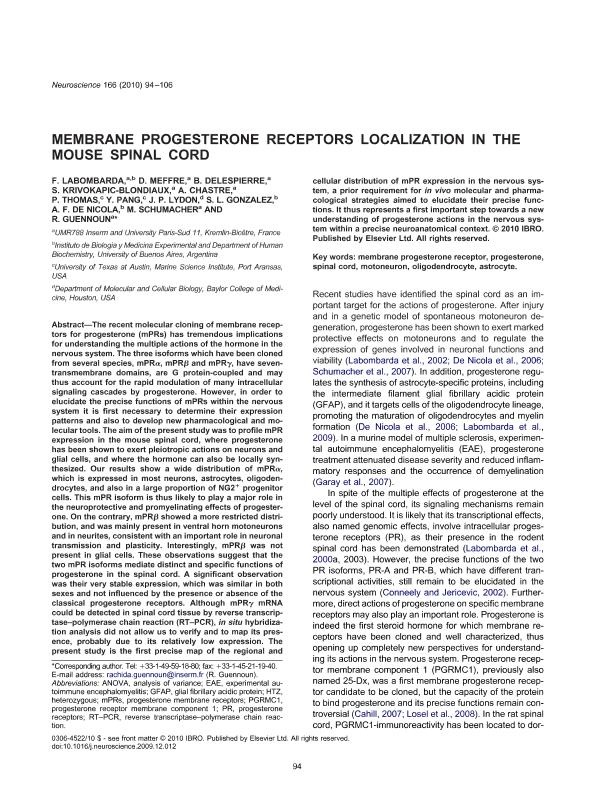Mostrar el registro sencillo del ítem
dc.contributor.author
Labombarda, Maria Florencia

dc.contributor.author
Meffre, D
dc.contributor.author
Delespierre, B
dc.contributor.author
Krivokapic Blondiaux, S.
dc.contributor.author
Chastre, A.
dc.contributor.author
Thomas, P.
dc.contributor.author
Pang, Y.
dc.contributor.author
Lydon, J. P.
dc.contributor.author
Gonzalez, Susana Laura

dc.contributor.author
de Nicola, Alejandro Federico

dc.contributor.author
Schumacher, Michael
dc.contributor.author
Gennoun, Rachida
dc.date.available
2017-03-28T14:57:27Z
dc.date.issued
2010-03-10
dc.identifier.citation
Labombarda, Maria Florencia; Meffre, D; Delespierre, B; Krivokapic Blondiaux, S.; Chastre, A.; et al.; Membrane progesterone receptors (mPRs) localisation in the mouse spinal. Neuroscience; Pergamon-elsevier Science Ltd; Neuroscience; 166; 1; 10-3-2010; 94-106
dc.identifier.issn
0306-4522
dc.identifier.uri
http://hdl.handle.net/11336/14383
dc.description.abstract
The recent molecular cloning of membrane receptors for progesterone (mPRs) has tremendous implications for understanding the multiple actions of the hormone in the nervous system. The three isoforms which have been cloned from several species, mPRalpha, mPRbeta and mPRgamma, have seven-transmembrane domains, are G protein-coupled and may thus account for the rapid modulation of many intracellular signaling cascades by progesterone. However, in order to elucidate the precise functions of mPRs within the nervous system it is first necessary to determine their expression patterns and also to develop new pharmacological and molecular tools. The aim of the present study was to profile mPR expression in the mouse spinal cord, where progesterone has been shown to exert pleiotropic actions on neurons and glial cells, and where the hormone can also be locally synthesized. Our results show a wide distribution of mPRalpha, which is expressed in most neurons, astrocytes, oligodendrocytes, and also in a large proportion of NG2(+) progenitor cells. This mPR isoform is thus likely to play a major role in the neuroprotective and promyelinating effects of progesterone. On the contrary, mPRbeta showed a more restricted distribution, and was mainly present in ventral horn motoneurons and in neurites, consistent with an important role in neuronal transmission and plasticity. Interestingly, mPRbeta was not present in glial cells. These observations suggest that the two mPR isoforms mediate distinct and specific functions of progesterone in the spinal cord. A significant observation was their very stable expression, which was similar in both sexes and not influenced by the presence or absence of the classical progesterone receptors. Although mPRgamma mRNA could be detected in spinal cord tissue by reverse transcriptase-polymerase chain reaction (RT-PCR), in situ hybridization analysis did not allow us to verify and to map its presence, probably due to its relatively low expression. The present study is the first precise map of the regional and cellular distribution of mPR expression in the nervous system, a prior requirement for in vivo molecular and pharmacological strategies aimed to elucidate their precise functions. It thus represents a first important step towards a new understanding of progesterone actions in the nervous system within a precise neuroanatomical context.
dc.format
application/pdf
dc.language.iso
eng
dc.publisher
Pergamon-elsevier Science Ltd

dc.rights
info:eu-repo/semantics/openAccess
dc.rights.uri
https://creativecommons.org/licenses/by-nc-nd/2.5/ar/
dc.subject
Membrane Progesterone Receptor
dc.subject
Progesterone
dc.subject
Spinal Cord
dc.subject.classification
Neurociencias

dc.subject.classification
Medicina Básica

dc.subject.classification
CIENCIAS MÉDICAS Y DE LA SALUD

dc.title
Membrane progesterone receptors (mPRs) localisation in the mouse spinal. Neuroscience
dc.type
info:eu-repo/semantics/article
dc.type
info:ar-repo/semantics/artículo
dc.type
info:eu-repo/semantics/publishedVersion
dc.date.updated
2017-03-23T18:23:40Z
dc.identifier.eissn
1873-7544
dc.journal.volume
166
dc.journal.number
1
dc.journal.pagination
94-106
dc.journal.pais
Estados Unidos

dc.journal.ciudad
Nueva York
dc.description.fil
Fil: Labombarda, Maria Florencia. Consejo Nacional de Investigaciones Científicas y Técnicas. Instituto de Biología y Medicina Experimental (i); Argentina; Argentina. Inserm; Francia. Universite Paris Sud; Francia. Universidad de Buenos Aires. Facultad de Medicina. Departamento de Bioquímica Humana; Argentina
dc.description.fil
Fil: Meffre, D. Inserm; Francia. Universite Paris Sud; Francia
dc.description.fil
Fil: Delespierre, B. Inserm; Francia. Universite Paris Sud; Francia
dc.description.fil
Fil: Krivokapic Blondiaux, S.. Inserm; Francia. Universite Paris Sud; Francia
dc.description.fil
Fil: Chastre, A.. Inserm; Francia. Universite Paris Sud; Francia
dc.description.fil
Fil: Thomas, P.. University of Texas at Austin; Estados Unidos
dc.description.fil
Fil: Pang, Y.. University of Texas at Austin; Estados Unidos
dc.description.fil
Fil: Lydon, J. P.. Baylor College of Medicine; Estados Unidos
dc.description.fil
Fil: Gonzalez, Susana Laura. Consejo Nacional de Investigaciones Científicas y Técnicas. Instituto de Biología y Medicina Experimental (i); Argentina; Argentina. Universidad de Buenos Aires. Facultad de Medicina. Departamento de Bioquímica Humana; Argentina
dc.description.fil
Fil: de Nicola, Alejandro Federico. Consejo Nacional de Investigaciones Científicas y Técnicas. Instituto de Biología y Medicina Experimental (i); Argentina; Argentina. Universidad de Buenos Aires. Facultad de Medicina. Departamento de Bioquímica Humana; Argentina
dc.description.fil
Fil: Schumacher, Michael. Inserm; Francia. Universite Paris Sud; Francia
dc.description.fil
Fil: Gennoun, Rachida. Inserm; Francia. Universite Paris Sud; Francia
dc.journal.title
Neuroscience

dc.relation.alternativeid
info:eu-repo/semantics/altIdentifier/url/http://www.sciencedirect.com/science/article/pii/S0306452209020454
dc.relation.alternativeid
info:eu-repo/semantics/altIdentifier/doi/http://dx.doi.org/10.1016/j.neuroscience.2009.12.012
Archivos asociados
